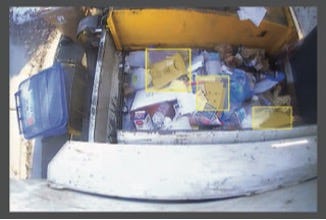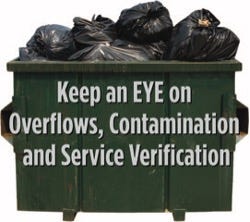Artificial Intelligence (AI) is a “Game Changer” for Waste Contamination Detection 60333
April 18, 2023

Sponsored Content
For as long as there has been recycling, there has been recycling contamination. The most challenging element of the problem was the inability to identify the source of the contamination. Artificial Intelligence (AI) software running on truck camera systems can cost-effectively monitor all lifts and tie contamination to a generator. This is an industry game-changer!
Contamination in a waste stream is anything that should not be in that waste stream. Typically, contamination in recycling waste streams includes plastic bags, diapers, styrofoam, and tanglers such as Christmas lights and hoses. These contaminants drive increased operational costs for MRFs, haulers, and the communities they serve.

“It used to be impossible to determine which commercial or residential generator was causing this contamination. This made education efforts expensive and ineffective,” said Tony Genovese, CTO of WasteVision AI. “AI technology on video telematics camera systems now scans every lift and can tie contamination events to their source.”
To enable AI technology, a waste truck will typically need a connected video telematics hopper camera. This allows the upload of hopper images/video that are processed through the WasteVision AI application to identify contaminants. It’s common to include a road facing windshield mounted camera or dashcam on FEL trucks to detect container overflows as well.
“We previously asked our drivers to take photos of overflowing containers. Driving a truck is difficult enough without having to take snap shots,” said Marc Schaener of JLT Trucking in Washington, DC. “The automated AI process identifies all overflows. This allows us to streamline the drivers’ workflow and work with our customers to right-size their service.”

The AI technology + camera solution has been implemented to traditional recycling programs across the US for cardboard and other valuable materials with measurable successes. Other waste streams have benefited as well. As an example, California’s SB 1383 mandates organic waste diversion for residential and commercial Municipalities and their haulers have utilized on truck camera systems running WasteVision AI software to enable monitoring of waste streams, including organics, for contamination.
“SB 1383 is moving into its enforcement phase. This requires comprehensive monitoring of residential and commercial disposal. While many municipalities relied on “lid flipping” in the early phases of SB 1383, that approach is insufficient and too expensive,” said Steve Witt, President of Driver Safety Technology. “SB 1383 has largely been an unfunded mandate. This technology will allow municipalities to charge those generators that are driving costs for the broader community. Without this visibility, municipalities have been forced to impose double-digit cost increases to all of its residents rather than those who are generating the contamination.”
Haulers also see safety and efficiency benefits with these systems. The same camera system that enables AI monitoring can be used for driver assistance safety, telematics solutions and capturing events or crashes for insurance.
“Our clients are really getting a two for one benefit,” said Witt. “The value of camera video telematics safety systems is well established. The fact that you can leverage these systems to enable these AI capabilities is really great for the industry. There is no doubt that this is the way of the future.”
WasteVision AI and Driver Safety Technology have partnered with Sensata INSIGHTS video telematics to create this industry first dual-purpose solution. The solution can be applied to all waste body brands with systems engineered for front loaders, side loaders and can be adapted to rear loaders.
WasteVision AI and Driver Safety Technology are showcasing these Ai software + Sensata INSIGHTS video telematics waste truck solutions at WasteExpo 2023 in New Orleans May 1 – 4 in Booth 255.
You May Also Like


.png?width=300&auto=webp&quality=80&disable=upscale)